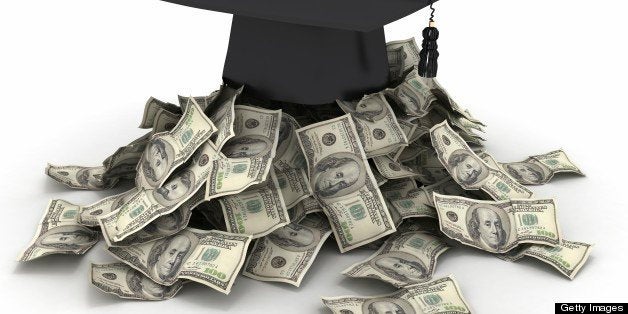
Just as markets over-built housing, mispriced mortgages and bid up prices beyond the real financial capacity of homebuyers, America's colleges and universities have over-expanded and over-priced their product. We are getting an education bubble with dynamics similar to the late housing bubble.
As more and more students find themselves with debts that exceed the salaries offered by the current job market, colleges have expanded beyond the capacity of their markets. Some kind of shakeout is coming. The question is: what kind.
During the long boom in higher education, colleges have also dramatically increased salaries and staffing levels of administrations. Some of this reflects efforts to game the rankings, which also is another aspect of the same imbalance.
For-profit universities, with high dropout rates, heavily reliant on federal Pell grants and student loans, are only the more explicit and extreme expression of a general trend of colleges and universities becoming more marketized. Colleges are doing deals to set up satellite campuses in sheikhdoms, recruiting full-tuition state-supported foreign students and creating vanity diploma mills as profit centers. The flip side is a massive disinvestment by state legislatures in America's great public universities and an under-investment in community colleges.
Despite the broad premise that the cure for America's poor economic performance is more and better colleges, resources have been skewed in exactly the wrong direction. A report by the Century Foundation released last week reveals that per-pupil spending in community colleges, where 44 percent of post-secondary students attend, most of them children of the non-rich rich, has been flat since 1999, while spending at elite private universities is up 31 percent.
There is a huge mismatch between the greatest need -- affordable public universities and community colleges -- and where the investment has gone. Basically, it has gone to overbuilding and hyper-competition in elite universities, too much money for administration and marketing, for-profits siphoning off resources and graduates being saddled with lifelong debt (except, of course, for graduates with affluent parents, who generally pay the freight, leaving their offspring debt-free.)
So now comes the shakeout. What form will it take?
One trend is a shift to the German model of one Herr Doktor Professor and lots of adjuncts. More and more courses, even at elite universities, are being taught by graduate students or permanent part-timers who barely make a living and have little time for students.
Another trend is the shift to one form or another of computer-based distance learning, as "massive open online courses" (MOOCs) become the next new thing. Despite the adjective, open, this also being seen as a profit center or a way to cut costs. Udacity, one of the for-profit MOOC vendors, has announced a partnership with Georgia Tech and AT&T that get you an MS degree for $7,000.
There are good and bad versions of the promise of online education. It forces the question: what is the function of the university? Is a university a community? Is its purpose the broad education of young adults, or is it a glorified trade school?
You can do trade school perfectly well from a distance at a computer, but at what cost to a "liberal" education? Or has a liberal education just become a fancy term for a finishing school and connections to the right people?
If you believe that there is some value-added to spending four years on a campus in a community of scholars, getting course credit for studying online with America's superstar professors can be a terrific complement to what you do locally, but not a total substitute. On the other hand, if elite education is just a four-year vacation for the children of the elite, bring on MOOCs.
Meanwhile, the risk is that a decent higher education gets further and further out of reach of the working class kids who most need it as a ladder of mobility. These are precisely the ones who are getting destroyed by student debt. They have higher dropout rates, partly because so many have to work part-time. Jason de Parle's authoritative piece on student debt and social class in the New York Times showed just how higher education increasingly reinforces class.
Clearly, our society cannot afford the current rate of expansion of higher education costs. We've reached the limits of piling these expenses onto students. But as resources become more scarce, as the consequences of over-expansion hit, the social risk is that the shoe will pinch even more intensely in the wrong places.
Everywhere you look in our new Gilded Age, public policy reinforces the lines of social class. Even in the original Gilded Age, America was also building free public universities. The Postwar boom was built on the free higher education of the G.I. Bill.
Surely, one area were we should counteract the inherited effects of class and emphasize upward mobility is the promise of higher education. But all the signs point to a shakeout in which elite universities and elite students come out fine, and others suffer.
Robert Kuttner's new book is Debtors' Prison: The Politics of Austerity Versus Possibility. He is co-editor of The American Prospect and a senior Fellow at Demos.
